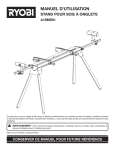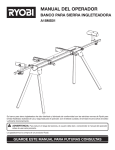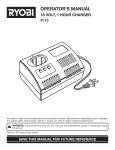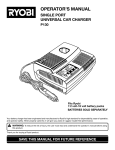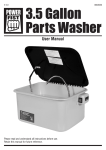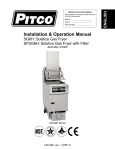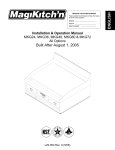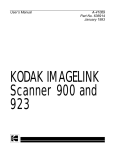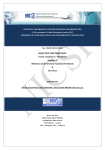Download Ryobi A18MS01 Saw User Manual
Transcript
OPERATOR’S MANUAL MITER SAW STAND A18MS01 Your miter saw stand has been engineered and manufactured to Ryobi’s high standard for dependability, ease of operation, and operator safety. When properly cared for, it will give you years of rugged, trouble-free performance. WARNING: To reduce the risk of injury, the user must read and understand the operator’s manual before using this product. Thank you for buying a Ryobi product. SAVE THIS MANUAL FOR FUTURE REFERENCE TABLE OF CONTENTS n Rules for Safe Operation ................................................................................................................................................. 2 n Symbols........................................................................................................................................................................ 3-4 n Features........................................................................................................................................................................... 4 �n Assembly ...................................................................................................................................................................... 5-9 �n Operation.................................................................................................................................................................... 9-11 �n Maintenance .................................................................................................................................................................. 12 RULES FOR SAFE OPERATION Safe operation of this accessory requires that you read and understand this operator’s manual, the operator’s manual for the table saw and all labels affixed to the tool. just to make sure that no problems will occur when the cut is made. n Do not modify or use this stand for any purpose for which it is not intended. READ ALL INSTRUCTIONS n This stand is designed to be used on a flat stable surface. Do not use the stand on an uneven surface. Be sure to allow enough room to handle and properly support the workpiece. n Know your accessory. Read the operator’s manual carefully. Learn its applications and limitations, as well as the specific potential hazards related to this accessory. n Follow the tool mounting instructions carefully, and ensure the tool is fastened securely. n Keep the work area clean. Cluttered work areas and work benches invite accidents. n �Maximum weight of the miter saw and workpiece together must not exceed 400 pounds. n Always wear safety glasses with side shields. Everyday glasses have only impact resistant lenses. They are NOT safety glasses. n Do not apply an unbalanced load that could cause the miter saw stand to tip over. n This stand will accommodate many miter saws. However, it should never be used on any miter saw with a blade diameter larger than 12 in. or with any slide miter saw with a blade diameter larger than 10 in. Always confirm any miter saw used is mounted securely and is stable before plugging in the miter saw. Before turning on the saw, perform a dry run of the cutting operation n Save these instructions. Refer to them frequently and use them to instruct others who may use this accessory. If you loan someone this accessory, loan them these instructions also to prevent misuse of the product and possible injury. WARNING: This stand is designed for use with miter saws with a blade diameter not larger than 12 in., or a slide miter saw with a blade diameter not larger than 10 in. 2 SYMBOLS Some of the following symbols may be used on this tool. Please study them and learn their meaning. Proper interpretation of these symbols will allow you to operate the tool better and safer. SYMBOL NAME DESIGNATION/EXPLANATION V Volts Voltage A Amperes Current Hz Hertz Frequency (cycles per second) W Watt Power Minutes Time Alternating Current Type of current Direct Current Type or a characteristic of current No Load Speed Rotational speed, at no load Class II Construction Double-insulated construction Per Minute Revolutions, strokes, surface speed, orbits etc., per minute Wet Conditions Alert Do not expose to rain or use in damp locations. Read The Operator’s Manual To reduce the risk of injury, user must read and understand operator’s manual before using this product. Eye Protection Always wear safety goggles, safety glasses with side shields, or a full face shield when operating this product. Safety Alert Precautions that involve your safety. No Hands Symbol Failure to keep your hands away from the blade will result in serious personal injury. No Hands Symbol Failure to keep your hands away from the blade will result in serious personal injury. Pinch Point To reduce the risk of injury or damage, avoid contact with any pinch point. No Hands Symbol Failure to keep your hands away from the blade will result in serious personal injury. Hot Surface To reduce the risk of injury or damage, avoid contact with any hot surface. min no .../min 3 SYMBOLS The following signal words and meanings are intended to explain the levels of risk associated with this product. SYMBOL SIGNAL MEANING DANGER: Indicates an imminently hazardous situation, which, if not avoided, will result in death or serious injury. WARNING: Indicates a potentially hazardous situation, which, if not avoided, could result in death or serious injury. CAUTION: Indicates a potentially hazardous situation, which, if not avoided, may result in minor or moderate injury. CAUTION: (Without Safety Alert Symbol) Indicates a situation that may result in property damage. FEATURES WORK STOP SAW MOUNTING BRACKET WORK STOP WORK SUPPORT MOUNTING BRACKET WORK SUPPORT WORK SUPPORT EXTENSION RAIL WORK SUPPORT MOUNTING BRACKET EXTENSION RAIL Fig. 1 4 ASSEMBLY UNPACKING WARNING: This product requires some assembly. n Carefully remove the tool and any accessories from the box. Make sure that all items listed in the packing list are included. n Inspect the tool carefully to make sure no breakage or damage occurred during shipping. n Do not discard the packing material until you have carefully inspected and satisfactorily operated the tool. n If any parts are damaged or missing, please call 1-800-525-2579 for assistance. Do not connect to power supply until assembly is complete. Failure to comply could result in accidental starting and possible serious personal injury. PACKING LIST Miter Saw Stand Saw Mounting Brackets (2) Work Supports (2) Work Support Mounting Brackets (2) Work Stops (2) Extension Adjustment Knobs (M8 x 25 mm) (2) Length Adjustment Knobs (M8 x 15 mm) (2) Height Adjustment Knobs (M8 x 15 mm) (2) Work Stop Adjustment Knobs (2) Carriage Bolts (M6 x 60 mm) (2) Carriage Bolts (5/16 in. x 2 in.) (4) Flat Washers (4) Lock Washers (4) Nuts (4) Operator’s Manual Warranty Registration Card WARNING: If any parts are missing do not operate this tool until the missing parts are replaced. Failure to do so could result in possible serious personal injury. WARNING: Do not attempt to modify this tool or create accessories not recommended for use with this tool. Any such alteration or modification is misuse and could result in a hazardous condition leading to possible serious personal injury. LEG LOCKING PIN Fig. 2 PREPARING THE STAND n Repeat with the remaining three legs. See Figure 2. n Lay the stand’s top surface down on the floor with the folded legs on top. n Lift the stand and place it in an upright position. n Check to ensure the stand is stable and all the legs have the locking pins engaged. n Push in a leg locking pin and rotate that leg up until the locking pin clicks into place. 5 ASSEMBLY ASSEMBLING AND INSTALLING MATERIAL WORK SUPPORTS WORK STOP See Figures 3 - 5. The material work supports help balance the workpiece during cutting operations. To assemble the work support: n Slide a carriage bolt (M6 x 60 mm) through the square hole in the work support and extend through the other side. CARRIAGE BOLT WORK STOP ADJUSTMENT KNOB n Place the work stop over the end of the bolt n Thread a work stop adjustment knob over the end of the bolt and tighten to secure. WORK SUPPORT n Slide the work support rail through the hole in the top of the work support mounting bracket. Fig. 3 n Insert the height adjustment knob through the small hole on the side of the work support mounting bracket and tighten to secure. WORK SUPPORT To install the work supports: n Slide the work support mounting bracket over the extension rail so that the extension rail extends through the opening in the bracket. Position the work support at the desired location on the extension rail. n Insert a length adjustment knob through the opening in the bottom of the work support mounting bracket and tighten to secure. WORK SUPPORT MOUNTING BRACKET n Repeat with the other support. ATTACHING SAW MOUNTING BRACKETS See Figures 6 - 7. Always position the saw to achieve maximum balance and stability. All four corners of the saw must be bolted to the mounting brackets before use. Make sure bolts do not extend above the table of the miter saw. If the saw has holes that line up with the slots in the saw mounting brackets: HEIGHT ADJUSTMENT KNOB Fig. 4 WORK SUPPORT n Unplug the saw and lock the saw arm in the down position. n Place a 2 x 4 or similar type of stable support underneath the saw to raise the saw and allow access to the saw’s mounting feet. n Place a saw mounting bracket underneath the raised side of the saw, aligning the mounting holes on the miter saw base with the slot in the top of the bracket. n Feed a carriage bolt up through both the bracket and a mounting hole in the saw. EXTENSION RAIL n Secure in place using a flat washer, lock washer and nut. n Repeat through the other end of the same bracket. n Place the second saw mounting bracket underneath the other side of the saw, aligning the mounting holes on the miter saw base with the opening in the bracket. LENGTH ADJUSTMENT KNOB 6 Fig. 5 ASSEMBLY MITER SAW NUT LOCK WASHER FLAT WASHER SAW MOUNTING BRACKET 2x4 SLOT CARRIAGE BOLT Fig. 6 n Mount the saw to a mounting surface at least 1/2 in. thick using 5/16 hex head screws, washers, and nuts (not included). n Install carriage bolts as previously described. n After making sure both brackets are parallel to each other, finger tighten all four nuts to hold in position. n Drill holes in the mounting surface to match the slots in the saw mounting brackets. If the saw has holes that do not line up with the slots in the saw mounting brackets: n Proceed with installation as previously described. n Unplug the saw and lock saw arm in the down position. MITER SAW NUT LOCK WASHER FLAT WASHER NUT LOCK WASHER MOUNTING SURFACE FLAT WASHER SAW MOUNTING BRACKET SLOT CARRIAGE BOLT Fig. 7 7 ASSEMBLY MOUNTING THE MITER SAW TO THE STAND n Lock the brackets in position by lowering the locking levers. See Figures 8 - 9. Use the handles located at the rear of the mounting brackets to aid in installing or removing saw and bracket assembly. n L � ift the saw and bracket assembly, allowing the assembly to tilt slightly toward your body. NOTE: Continue to hold the mounting bracket assembly with one hand until both levers are securely locked. n Check position and adjust, if necessary, to make sure the weight of the saw is evenly balanced over the rails as shown in figure 9. n While still tilted toward you, hook the front edge of the bracket assembly onto the front rail of the stand. n Ensure the saw is fully seated and locked in position, then securely tighten the four nuts holding the saw to the saw mounting brackets. WARNING: �To remove saw from stand: To avoid serious personal injury, make sure the curved front edge of the mounting brackets are securely seated over the front rail before seating the other end of the brackets. Failure to do so could cause you to lose control of the saw mounting assembly, which could cause serious personal injury. n Raise the locking levers to unlock the saw and mounting bracket assembly. �n Grasp the handles on either side of the assembly and lift away from the rear rail of the stand to disengage. n �With the assembly tilted slightly toward you, lift the front part of the assembly to disengage from the front rail of the stand. n Lower the bracket assembly to allow the rear edge of the bracket to seat fully over the rear rail. �� �� �� �� �� �� �� �� �� �� �� �� �� �� � � � � � � � � � � � �� � �� � �� � �� � �� � �� � �� � �� � �� �� �� �� �� �� �� �� �� �� �� � �� � �� � �� � �� � �� � �� � �� � �� � �� � � � � � � � � � � �� �� �� �� �� �� �� �� �� �� �� �� �� �� Fig. 8 WARNING: The mounting brackets are designed to fit snugly over the stand rails. With the locking levers in the lowered (locked) position, you should not be able to remove the saw and bracket assembly from the rails. If the mounting brackets will not fit over the rails, or if the mounting brackets can be removed from the rails when the levers are locked, remove from the saw and bracket assembly immediately and tighten the bracket adjustment screw as described in the Maintenance section of this manual. Failure to heed this warning may result in serious personal injury. 8 ASSEMBLY �� �� �� �� �� �� �� �� �� �� �� �� �� �� � � � � � � � � � � � � � � � � � � � �� �� �� �� �� �� �� �� �� �� �� �� �� �� LOWER LOCKING LEVERS TO SECURE TO STAND Fig. 9 OPERATION WARNING: WARNING: Do not use any attachments or accessories not recommended by the manufacturer of this tool. The use of attachments or accessories not recommended can result in serious personal injury. Do not allow familiarity with tools to make you careless. Remember that a careless fraction of a second is sufficient to inflict serious injury. WARNING: APPLICATIONS You may use this tool for the following purpose: Always wear safety goggles or safety glasses with side shields when operating tools. Failure to do so could result in objects being thrown into your eyes, resulting in possible serious injury. n To provide a stable, secure work surface for a miter saw 9 OPERATION USING THE EXTENSION RAILS BUILDING AND INSTALLING AN OPTIONAL WORKSHELF See Figure 10. Use the extension rails when working with larger workpieces. To extend the rails: n Loosen the extension adjustment knob. See Figures 12 - 14. Use the following directions, if desired, to build a workshelf for the miter stand. Materials needed: n Extend the rail to the desired position. n 9 x 20 in. plywood, 3/4 in. thick n Tighten the extension adjustment knob. n 8 wood screws, 1-1/4 in. length n Drill and bit to drill and countersink screw holes Building the workshelf: n Make cuts as shown in the cutting diagram below. EXTENSION RAIL 3/4" 3/4" 3/4" 3 1/2" EXTENSION ADJUSTMENT KNOB Fig. 10 USING THE WORK STOPS See Figure 11. Raise the work stops whenever you need to make repetitive cuts of the same size. To avoid a greater risk of binding or pinching, do not use both work stops at the same time. To raise the work stops: 13" n Loosen the work stop adjustment knob. n Raise the work stop to the desired position. n Tighten the work stop adjustment knob. WORK STOP 9" WORK STOP ADJUSTMENT KNOB Fig. 12 n Cut the ends of the three 3/4 in. pieces so that two are 6 in. long and one is 7-1/2 in. long. n Align the two 3/4 x 6 in. plywood strips vertically along the left and right sides of the 9 x 13 in. base, making sure the front edges are flush. n Pre-drill and countersink holes for screws in each of the strips as shown in figure 10; install screws. Fig. 11 NOTE: Locate the screws at least 2 in. away from the bottom corners of the assembly. 10 OPERATION n Insert the 3/4 x 7-1/2 in. plywood strip horizontally between the 6 in. strips, making sure the long edge is flush with the base. UPPER TUBE n Pre-drill and countersink two holes; install screws. NOTE: The corners of the shelf can now be mitered, if desired, to remove sharp edges. LOWER TUBE LOWER TUBE n Place the 3-1/2 x 9 in. piece of plywood horizontally 1-3/4 in. above the vertical plywood strips. Make sure the left and right edges of the wood are flush with the sides of the base. UPPER TUBE n Pre-drill and countersink two holes in the center of wood as shown. Installing the workshelf: n Remove the 3-1/2 x 9 in. plywood and insert shelf between top and bottom rails of miter stand until edge of vertical strips touch miter stand front rail. 6" n Place the 3-1/2 x 9 in. plywood between the front and back rails of the miter stand. Re-align the pre-drilled holes in the top piece with the pre-drilled holes in the base of the shelf. 7 1/2" n Install screws in pre-drilled holes to secure shelf. 3/4" 9" Fig. 13 BACK RAIL 1-3/4 in. WOOD SCREWS �� �� �� �� �� �� �� �� �� �� �� �� �� �� � � � � 3-1/2 x 9 in. PLYWOOD � � � � � � � � � � � � � � � �� �� �� �� �� �� FRONT RAIL �� �� �� �� �� �� �� �� VERTICAL STRIP SHELF BASE Fig. 14 11 MAINTENANCE To adjust: n Use a wrench to slightly loosen the nut. WARNING: When servicing, use only identical Ryobi replacement parts. Use of any other parts may create a hazard or cause product damage. n Turn the screw with a phillips screwdriver. Rotate clockwise if the bracket assembly needs to be tightened or counterclockwise if the assembly needs to be loosened. n Install the bracket on the miter stand rails and lower the locking lever to check the adjustment. WARNING: Always wear safety goggles or safety glasses with side shields during power tool operation or when blowing dust. If operation is dusty, also wear a dust mask. n When the correct position is achieved, wrench tighten the nut to secure. n Repeat with the second mounting bracket. GENERAL MAINTENANCE MOUNTING BRACKET Avoid using solvents when cleaning plastic parts. Most plastics are susceptible to damage from various types of commercial solvents and may be damaged by their use. Use clean cloths to remove dirt, dust, oil, grease, etc. WRENCH WARNING: Do not at any time let brake fluids, gasoline, petroleumbased products, penetrating oils, etc., come in contact with plastic parts. Chemicals can damage, weaken or destroy plastic which may result in serious personal injury. BRACKET ADJUSTMENT SCREW See Figure 15. Mounting brackets are designed to fit snugly over the stand rails. With the locking levers in the lowered (locked) position, you should not be able to remove the saw and bracket assembly from the rails. If the saw and bracket assembly can be removed from the rails when the levers are locked, the bracket adjustment screws need to be tightened. If the saw and bracket assembly will not fit over both rails, the bracket adjustment screws needs to be loosened. NOTE: The saw should be removed from the mounting brackets before attempting to tighten or loosen the bracket adjustment screws. NUT SCREWDRIVER BRACKET ADJUSTMENT SCREW Fig. 15 RYOBI TECHNOLOGIES, INC. 1428 Pearman Dairy Road, Anderson, SC 29625 Post Office Box 1207, Anderson, SC 29622-1207 Phone 1-800-525-2579 www.ryobitools.com 983000-710 5-05












